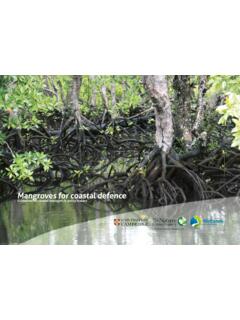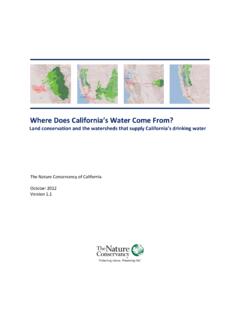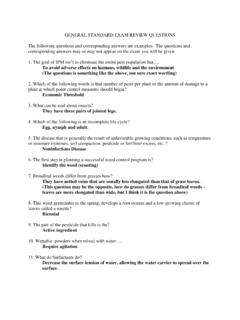Transcription of ECOLOGICAL BUFFERS - The Nature Conservancy
1 1 ECOLOGICAL BUFFERS | Reducing ECOLOGICAL Impacts of Shale Development | | 2015 STATE OF THE RESEARCHS ignificant research exists documenting the importance and effectiveness of maintaining riparian BUFFERS around streams, lakes and wetlands to minimize impacts to water 3 Most of this research is derived from monitoring responses to forestry and agricultural practices. In addition to reducing development impacts to water quality, riparian BUFFERS have also been shown to provide habitat and movement corridors for many species of birds, mammals, reptiles, fish and and interior BUFFERS help lessen impacts to species that rely on other habitat types, such as caves or interior forest habitat, and protect areas import-ant to breeding, rearing and , 4 -11 Although these BUFFERS fill an important role, studies specific to buffer widths needed to protect these species are relatively factors influence the determina-tion of a buffer width that is effective, including the targeted function of the buffer (.)
2 To reduce erosion or protect raptor nesting habitat) and landscape characteristics, like slope, geology and ,12 16 Riparian BUFFERS that are effective in maintaining species diversity are often wider than those required to reduce sedimentation. Width is not the only factor that deter-mines buffer effectiveness; BUFFERS that are continuous around the perimeter or along the length of a sensitive habitat ECOLOGICAL BUFFERSE cological BUFFERS are protected zones established around sensitive or critical areas such as wildlife breeding or hibernation habitats, streams, and wetlands to lessen the impacts of human activity and land disturbance. Well pads, roads and pipelines developed for shale oil and gas development reduce and fragment native forests, rivers and natural grasslands, reducing the quality of migration, foraging and nesting habitats for fish and wildlife.
3 Changes in land cover can also have a negative impact on water quality and watershed health. ECOLOGICAL BUFFERS may be used to reduce or minimize the risks of land use disturbance and proximity of infrastructure specifically associated with shale energy development. Mark Godfrey, TNCarea can be more effective than frag-mented BUFFERS in providing fish and wildlife habitat and preserving ecosystem ,3,6,17 Conservation strategies that target landscape-scale planning, including the configuration and connec-tivity of BUFFERS and cumulative watershed development are most effective at supporting regional ,5,11,18 22 Studies specific to habitats and species in the Appalachian region and to shale energy infrastructure could improve the effectiveness of conservation strategies as development expands.
4 This document does not address BUFFERS necessary to minimize ECOLOGICAL risks associated with the transport, use, storage or disposal of fracturing chemicals, nor does it address BUFFERS to minimize for air-quality impacts associated with shale ECOLOGICAL Impacts of Shale Development: RECOMMENDED PRACTICES FOR THE APPALACHIANS2 ECOLOGICAL BUFFERS | Reducing ECOLOGICAL Impacts of Shale Development | | 2015 EVIDENCE OF IMPACT Disturbance to Fish and Wildlife HabitatFish and wildlife need stream, riparian and upland habitat for breeding, nesting and hibernation, as well as the ability to move through the 6 Effects of energy development including frag-mentation, noise and light pollution, human activity, and the spread of invasive species can result in disturbance to and loss of these valuable habitat areas, which can lead to reduced reproductive rates and changes in ,24 For example.
5 Disturbance around raptor nests ( hawks and eagles) during the breeding season can result in avoidance behavior that interferes with feeding and rearing behavior or an abandonment of eggs or ,25,26 Development can also accelerate the spread of invasive species that compete with native species and alter Appalachian 7, 28 While BUFFERS can lessen disturbances to wildlife and important habitat areas, many forest-dependent species still require protection of larger, high-quality upland or interior habitat areas to survive and 6 Mammals can lose valuable habitat and the ability to move through the land-scape as a result of habitat loss and 6 Riparian BUFFERS can protect foraging habitat for small and semi-aquatic mammals.
6 Such as river otter and water shrew, and act as movement corridors for larger mammals like bobcat, red fox, deer and black 6 Upland and interior BUFFERS around caves and bat hibernacula can help lessen the disturbances to bats and other cave-dwelling can be exposed to higher rates of nest predation and lose valuable habitat from the effects of energy Riparian BUFFERS of a sufficient width are able to support many riparian and woodland birds and have been associated with lower nest preda-tion rates, however they are unlikely to maintain most forest-interior bird species that rely on large areas of intact forest ,5 Reptiles and amphibians can lose critical aquatic, riparian and upland habitats used for foraging, overwintering, breeding and nesting as a result of energy ,18 2 0 The benefits and effectiveness of BUFFERS around these habitats vary widely between ,4,33 Generally, conservation strategies that extend beyond riparian BUFFERS and also maintain a connected landscape with relatively large areas of natural forest and wetlands are more Maintaining healthy stream and wetland habitats is also important to reptiles and amphibians during their aquatic life stage.
7 For example, increased sediment has been shown to reduce tadpole densities and smother eastern hellbend-er salamander ,42 Fish and aquatic invertebrates can be impacted by the effects of energy development near streams, wetlands and vernal pools , including changes to stream characteristics such as temperature, light and sediment that can cause changes in community ,43-45 Freshwater mussels, which play an important part in stream and lake ecosystems by providing habitat and influencing food availability, are one example of a species that could be INTERIOR FORESTBUFFERCONNECTIVITY OFBUFFERSRIPARIANBUFFERI nterior forest and upland BUFFERS can protect interior forest areas, provide connectivity between different habitat types, and reduce disturbances to critical breeding and nesting BuffersConnectivity of BUFFERS is essential in reducing impacts of development and allowing species to move across the landscape and access vital 0 300 1,300 200 WILDLIFEORGANIC MATTERAND DEBRISFLOODCONTROLTEMPERATUREEROSIONE ffective buffer width depends upon a variety of factors, such as slope, vegetation and adapted from Figure of Stream Corridor Restoration: Principles, Processes, and Practices by the Federal Interagency Restoration Working Group Riparian BUFFERS along streams, lakes and wetlands can help to lessen the impacts of nearby development.
8 Riparian areas also provide habitat for a variety of plant and animal species and protect water quality and aquatic WIDTH3 ECOLOGICAL BUFFERS | Reducing ECOLOGICAL Impacts of Shale Development | | 2015significantly improve water quality if headwater networks lack adequate Wetland, vernal and floodplain complexes provide essential ECOLOGICAL functions, such as water storage, groundwater replenishment, and sediment and nutrient retention that can be impacted by , 5 8 These systems also contribute significantly to local biodiversity, providing critical habitat for diverse, and in many cases rare, groups of Flow and Temperature Loss of vegetated riparian BUFFERS along streams, lakes and wetlands can result in a loss of flood retention and base flow regulation.
9 Without adequate vegetated BUFFERS , the ability of floodplains to store flood flows associated with major storm events and wet seasons might be significantly reduced, resulting in increased flooding and BUFFERS that fail to extend along an entire stream length, regardless of size, might result in a loss of these ,12,60 Forested riparian BUFFERS provide shade, which can help maintain stream tem-peratures, as well as food and cover for many aquatic ,6,56,61 For headwa-ters, creeks and small rivers, a riparian buffer that does not extend shade to at least half of the stream or wetland might increase risk to the temperature regime, impacting fish and invertebrate ,5,21,61 This risk is greater for cold-cool water habitats and species, such as brook trout, that require cooler waters to survive and are less tolerant of large temperature fluctuations and therefore might require wider ,34,56,62 Regulate Sediment, Nutrients and Organic MatterA major function of riparian BUFFERS is to control erosion and sedimentation by stabilizing banks and filtering sediments and ,60,63 Sedimentation can negatively affect water quality and aquatic species, as well as alter stream and wetland In addition, sedimentation reduces the amount of light in the water column which can decrease primary production ( submerged vegetation or zooplankton).
10 This can cause cascading effects throughout the ecosystem and signifi-cantly reduce populations of aquatic organisms through mortality, reduced physiological condition and habitat ,65 Riparian BUFFERS capture and slowly filter the overland runoff of stormwater and nutrients, which can otherwise stress aquatic Reptiles, like the eastern box turtle, need a variety of habitats for foraging, breeding and nesting activities. Maintaining riparian BUFFERS and connectivity between habitat areas is important. Kent MasonStreams create important fish and wildlife habitat and provide essential aquatic ecosystem processes. Jack Millsnegatively impacted by inadequate BUFFERS . They are particularly sensitive to changes in water The Appala-chian region hosts dozens of freshwater mussel species, several of which are federally to Aquatic Ecosystem ProcessesStream, lake and wetland ecosystems work to retain floods, regulate stream temperatures, and filter sediment and nutrients.










